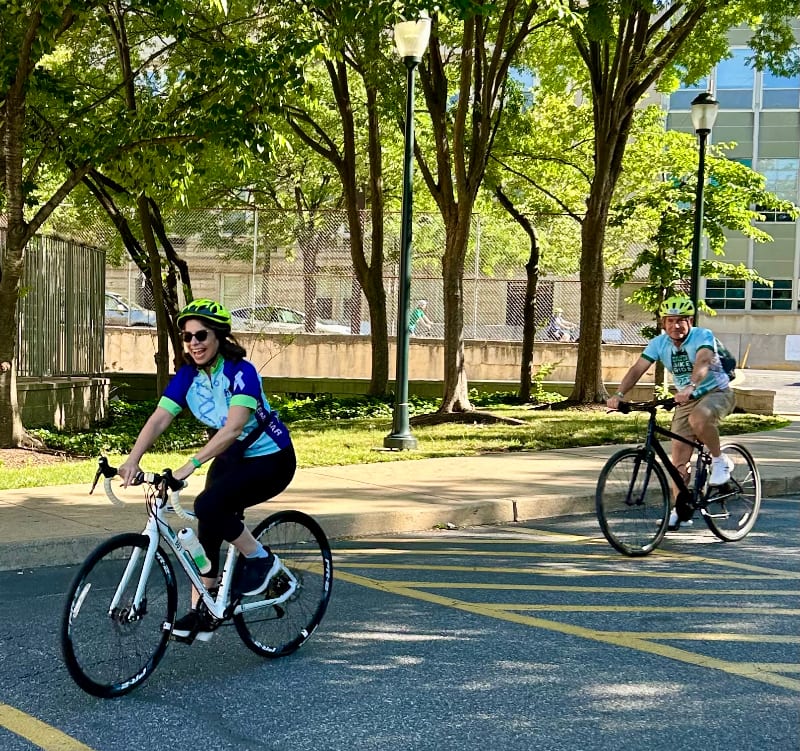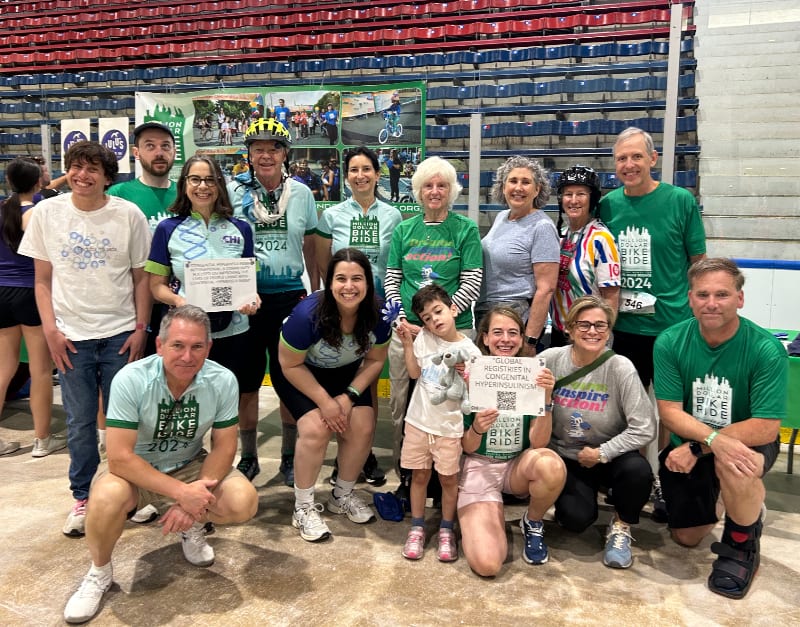I’m so glad we are going to Philadelphia and it isn’t for a doctor’s appointment, Ben said, as we were driving to that city for the Million Dollar Bike Ride.
Driving South from New Jersey, there wasn’t much traffic and the weather was perfect. When we arrived in Philadelphia, we checked into our hotel, which was quite a feat because we had to squeeze ourselves and our bikes into a small elevator to get to our room. Then, we headed over to the Penn Ice rink and the adjacent Orphan Disease Center (ODC) of the University of Pennsylvania to get our bibbs for the ride the next day, and to say hello to the leaders of the ODC and the organizers of the ride, Jim Wilson and Monique Molloy. It still seems like yesterday that I was introduced to them, but it was actually ten years ago that the first Million Dollar Bike Ride took place. Since then, together with rare disease organizations, the ODC has raised close to 20 million dollars for rare disease research. This event has given us the opportunity to fund ten hyperinsulinism research grants, teaching us critical information about HI and getting our community closer to better treatments. Last Saturday morning, we gathered before 7 am for the start of the ride, which would be staggered based on the chosen route. I was so happy to see our team members, many of whom come year after year to be part of this event. Doctors, scientists, family members, supporters, all assembled to transform hope into action for congenital hyperinsulinism research.
And then the ride was about to start. We were in a sea of people, on wheels, as if in a crowded European city where everyone gets around by bike. Our 10-mile CHIbra team members started the ride together. Most of the streets were cleared of cars for us. We made our way past the Art Museum to lush Fairmount Park, where the majority of the ride takes place. We rode along the Schuylkill River on MLK Drive to the Falls Bridge and back. I am full of gratitude for all the busy people who come out to support our team, year after year. For the first half of this year’s ride, I got to ride next to Dr. Charles Stanley, the Founder of the CHOP Congenital Hyperinsulinism Center. Dr. Stanley has joined us in many years past, as well. He’s a triple supporter, with a tremendous career as a clinician and researcher, and now as CHI’s number one volunteer!
There have been years when it is extremely chilly, with rain threatening, and years when it was blistering hot. This year was downright perfect. Low humidity, brilliant blue sky, no wind. Pure joy to ride.
It seemed like no time before we were back at the Finish Line. Jennifer Schmitt, CHI’s COO and dedicated Captain of the Team was there to wave us in, together with my son Ben, who is the team’s Chief Greeter.

After the ride, we waited for our 30+ mile riders in the Penn Ice Rink (which was not filled with ice, but instead was filled with round tables and lots of treats) for a post ride snack and chatting. There is always something to learn at the rare disease organization booths that encircle the space, and it is so nice to catch up with friends from other rare disease organizations.
Finally, it was time to greet our 32-mile riders, including my husband, Mark. We were so proud of him for attempting and completing this route that has several long and challenging climbs, up some big hills. We were shocked that he made it back so quickly.

For months before the ride and for a few weeks after, each rare disease team provides an opportunity for people in their community to donate to their respective teams. The funds are collected, and the first $30,000 for each team are matched by the University of Pennsylvania ODC. This generous match makes each donation even more impactful. And just like that, year after, another grant opportunity for a brilliant researcher with a hypothesis related to improving the lives of people born with hyperinsulinism, is made available. All the other patient organizations who participate are raising funds in just the same way for rare disease research for the communities they represent.
In the ten years I have been a part of this magical process, over $743,000 dollars has been raised for 10 different grants for hyperinsulinism research. Not only does the University of Pennsylvania match the funding, but they also administer the grant, so there aren’t any admin fees.
And what is the impact of these grants? Ten research grants have been in the following categories:
- Pilot studies on specific treatments and devices that are meant to reduce hypoglycemia from congenital hyperinsulinism (2014, 2015 2016, 2017, 2018)
- Translating basic science into the development of new therapies for congenital hyperinsulinism (2019, 2023)
- Natural history projects which track the experience of living with congenital hyperinsulinism across the different phases of life (2020, 2021)
- Genetic discovery projects which help to provide more targeted genetic diagnoses of congenital hyperinsulinism, which can lead to more personalized treatments in the future (2022)
- Pilot studies for a treatment for hyperinsulinism subtypes like hyperinsulinism/hyperammonemia (2016, 2018, 2019)
Treatment development takes time, so some of the most impactful potential outcomes may still be in development. Others have shorter timelines. The learnings from these pilot grants feed into larger projects, and have an impact on diagnostics and care guidelines, as well. You can learn more about our past grant winners’ work here.
If you’d like to support this year’s pilot research grant to help increase knowledge and awareness of hyperinsulinism, I encourage you to visit our donation page. There is still time for your support to go even further thanks to the University of Pennsylvania’s generous match. When we made it back to New Jersey, the sun was still shining, and our moods matched the weather. I’m confident our team members will be “raring to go” at the same time next year, and I am hopeful we will have many new riders and volunteers, and more exciting and fruitful research projects.



